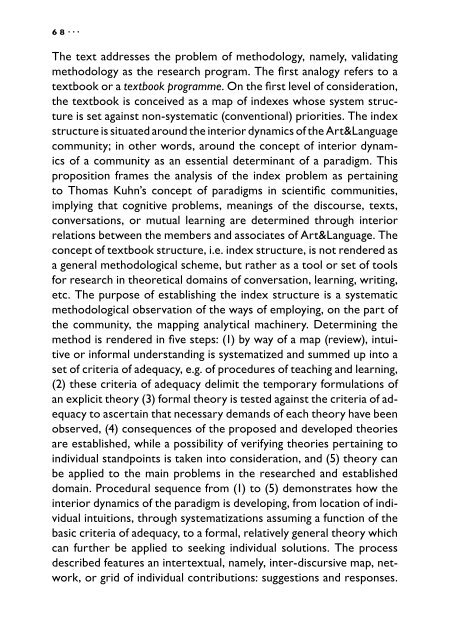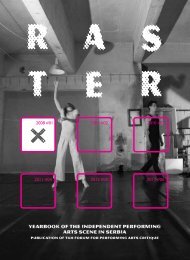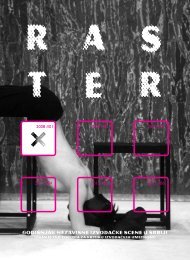Miško Šuvaković Epistemology of Art - TkH
Miško Šuvaković Epistemology of Art - TkH
Miško Šuvaković Epistemology of Art - TkH
Create successful ePaper yourself
Turn your PDF publications into a flip-book with our unique Google optimized e-Paper software.
68··· ··· 69<br />
The text addresses the problem <strong>of</strong> methodology, namely, validating<br />
methodology as the research program. The first analogy refers to a<br />
textbook or a textbook programme. On the first level <strong>of</strong> consideration,<br />
the textbook is conceived as a map <strong>of</strong> indexes whose system structure<br />
is set against non-systematic (conventional) priorities. The index<br />
structure is situated around the interior dynamics <strong>of</strong> the <strong>Art</strong>&Language<br />
community; in other words, around the concept <strong>of</strong> interior dynamics<br />
<strong>of</strong> a community as an essential determinant <strong>of</strong> a paradigm. This<br />
proposition frames the analysis <strong>of</strong> the index problem as pertaining<br />
to Thomas Kuhn’s concept <strong>of</strong> paradigms in scientific communities,<br />
implying that cognitive problems, meanings <strong>of</strong> the discourse, texts,<br />
conversations, or mutual learning are determined through interior<br />
relations between the members and associates <strong>of</strong> <strong>Art</strong>&Language. The<br />
concept <strong>of</strong> textbook structure, i.e. index structure, is not rendered as<br />
a general methodological scheme, but rather as a tool or set <strong>of</strong> tools<br />
for research in theoretical domains <strong>of</strong> conversation, learning, writing,<br />
etc. The purpose <strong>of</strong> establishing the index structure is a systematic<br />
methodological observation <strong>of</strong> the ways <strong>of</strong> employing, on the part <strong>of</strong><br />
the community, the mapping analytical machinery. Determining the<br />
method is rendered in five steps: (1) by way <strong>of</strong> a map (review), intuitive<br />
or informal understanding is systematized and summed up into a<br />
set <strong>of</strong> criteria <strong>of</strong> adequacy, e.g. <strong>of</strong> procedures <strong>of</strong> teaching and learning,<br />
(2) these criteria <strong>of</strong> adequacy delimit the temporary formulations <strong>of</strong><br />
an explicit theory (3) formal theory is tested against the criteria <strong>of</strong> adequacy<br />
to ascertain that necessary demands <strong>of</strong> each theory have been<br />
observed, (4) consequences <strong>of</strong> the proposed and developed theories<br />
are established, while a possibility <strong>of</strong> verifying theories pertaining to<br />
individual standpoints is taken into consideration, and (5) theory can<br />
be applied to the main problems in the researched and established<br />
domain. Procedural sequence from (1) to (5) demonstrates how the<br />
interior dynamics <strong>of</strong> the paradigm is developing, from location <strong>of</strong> individual<br />
intuitions, through systematizations assuming a function <strong>of</strong> the<br />
basic criteria <strong>of</strong> adequacy, to a formal, relatively general theory which<br />
can further be applied to seeking individual solutions. The process<br />
described features an intertextual, namely, inter-discursive map, network,<br />
or grid <strong>of</strong> individual contributions: suggestions and responses.<br />
Individual contribution to this analogous textbook system is always<br />
an unperfected order <strong>of</strong> elements, while network, mapping, or grid<br />
features <strong>of</strong> the order dictate the value and meaning <strong>of</strong> individual elements.<br />
Conceptual and semantic superposition <strong>of</strong> structure to the element<br />
indicates that <strong>Art</strong>&Language theory <strong>of</strong> indexes is devised from<br />
holistic principles. Individual conventions establish an unperfected<br />
empirical order, while two types <strong>of</strong> generalizations can be acknowledged:<br />
(a) first are abstract or hierarchical and establish difference<br />
in type, and (b) other pertain to analogies and establish difference in<br />
degree. The grid structure is based on a polar concept:<br />
The concept <strong>of</strong> a lath is a polar concept, it registers the continuous<br />
polarity rather than discrete separation, <strong>of</strong> the formal and, as it<br />
were ‘intuitional’ or ‘material’ modes <strong>of</strong> experience. The determinate<br />
characterisation <strong>of</strong> either pole requires some kind <strong>of</strong> reference<br />
to the other. The status <strong>of</strong> the indices compatible with the propositional<br />
attitudes <strong>of</strong> a single contributor is essentially ideological. The<br />
institute may be looked at as a corpus <strong>of</strong> ideological commitments<br />
compromising a field. The problems are essentially regarded as ‘objective’.<br />
The Activity may be regarded as a generally focused search<br />
for methodologies: i.e. for a general methodological horizon. 113<br />
This quote underlines three crucial positions <strong>of</strong> the theory <strong>of</strong> indexes:<br />
(1) holistic character <strong>of</strong> the structure <strong>of</strong> polarities establishing correlative<br />
references; namely, semantic value <strong>of</strong> one polarity is determined<br />
by its place in the structure <strong>of</strong> indexes and relations with other<br />
polarities <strong>of</strong> the network, (2) ideological position (ideological body<br />
pertaining to the community) is derived from individual positions, circumscribed<br />
in the pattern <strong>of</strong> propositional utterances – statements<br />
comprising a premise (position, viewpoint) and a proposition, and (3)<br />
acting in the locale (discursive space) <strong>of</strong> holistic structuration and<br />
ideological demarcation <strong>of</strong> procedures means searching for a method.<br />
These three positions <strong>of</strong> <strong>Art</strong>&Language feature juxtaposed concerns<br />
<strong>of</strong> analytical philosophy (structural semantic holism, methodology)<br />
113 <strong>Art</strong>&Language, „The <strong>Art</strong>-Language Institute: Sugestions for a Map“, pp. 17.16-<br />
17.18.







